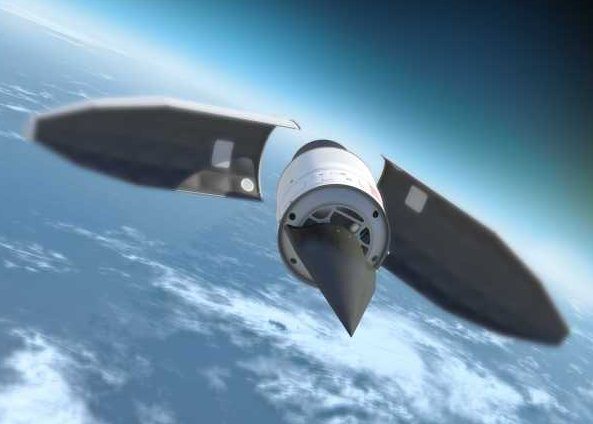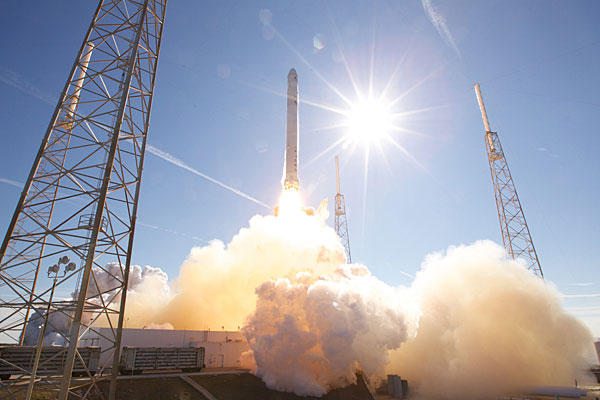Following an extensive seven-month analysis of data collected from the Aug. 11, 2011, second flight of DARPA’s Hypersonic Technology Vehicle (HTV-2), an independent engineering review board (ERB) investigating the cause of a flight anomaly completed its report. The findings of the ERB validated the vehicle’s aerodynamic design and uncovered new information regarding the thermal material properties of the vehicle.
“The greatest achievement from Flight Two, which the ERB’s findings underscored, was that we successfully incorporated aerodynamic knowledge gained from the first flight into the second flight,” said Air Force Maj. Chris Schulz, DARPA program manager, who holds a doctorate in aerospace engineering.
A technology demonstration and data-gathering platform, the HTV-2’s second test flight was conducted to validate current models and increase technical understanding of the hypersonic regime. The flight successfully demonstrated stable aerodynamically-controlled flight at speeds up to Mach 20 (twenty times the speed of sound) for nearly three minutes. Approximately nine minutes into the test flight, the vehicle experienced a series of shocks culminating in an anomaly, which prompted the autonomous flight safety system to use the vehicle’s aerodynamic systems to make a controlled descent and splashdown into the ocean.
“The initial shockwave disturbances experienced during second flight, from which the vehicle was able to recover and continue controlled flight, exceeded by more than 100 times what the vehicle was designed to withstand,” said DARPA Acting Director, Kaigham J. Gabriel. “That’s a major validation that we’re advancing our understanding of aerodynamic control for hypersonic flight.”
The ERB concluded that the “most probable cause of the HTV-2 Flight 2 premature flight termination was unexpected aeroshell degradation, creating multiple upsets of increasing severity that ultimately activated the Flight Safety System.”
Based on state-of-the-art models, ground testing of high-temperature materials and understanding of thermal effects in other more well-known flight regimes, a gradual wearing away of the vehicle’s skin as it reached stress tolerance limits was expected. However, larger than anticipated portions of the vehicle’s skin peeled from the aerostructure. The resulting gaps created strong, impulsive shock waves around the vehicle as it travelled nearly 13,000 miles per hour, causing the vehicle to roll abruptly. Based on knowledge gained from the first flight in 2010 and incorporated into the second flight, the vehicle’s aerodynamic stability allowed it to right itself successfully after several shockwave-induced rolls. Eventually, however, the severity of the continued disturbances finally exceeded the vehicle’s ability to recover.
According to Schulz, “HTV-2’s first flight test corrected our models regarding aerodynamic design within this flight regime. We applied that data in flight test two, which ultimately led to stable aerodynamically controlled flight. Data collected during the second test flight revealed new knowledge about thermal-protective material properties and uncertainties for Mach 20 flight inside the atmosphere, which can now be used to adjust our assumptions based on actual flight data and modify our modeling and simulation to better characterize thermal uncertainties and determine how to assess integrated thermal systems.”
Aerodynamic assumptions and extrapolations from known flight regimes proved inadequate when preparing for HTV-2 inaugural flight test. The data from second flight revealed that extrapolating from known flight regimes and relying solely on advanced thermal modeling and ground testing could not successfully predict the harsh realities of Mach 20 atmospheric flight.
“A group of nationally-recognized experts from government and academia came together to analyze the flight data and conduct extensive additional modeling and ground testing for this review,” Schulz said. “The result of these findings is a profound advancement in understanding the areas we need to focus on to advance aerothermal structures for future hypersonic vehicles. Only actual flight data could have revealed this to us.”
Moving forward, the HTV-2 program will incorporate new knowledge gained to improve models for characterizing thermal uncertainties and heat-stress allowances for the vehicle’s outer shell. The remediation phase will involve further analysis and ground testing using flight data to validate new tools for this flight regime. The ERB findings and remediation phase efforts will inform policy, acquisition and operational decisions for future Conventional Prompt Global Strike initiatives executed by the Office of the Secretary of Defense, Acquisition, Technology & Logistics, Strategic Warfare directorate—the goal of which, ultimately, is to have the capability to reach anywhere in the world in less than one hour.











